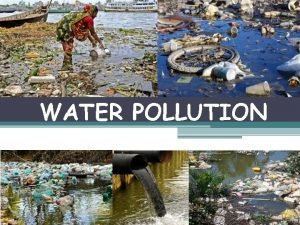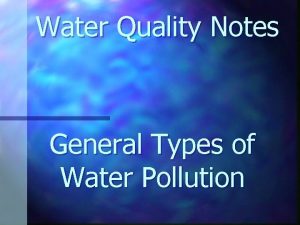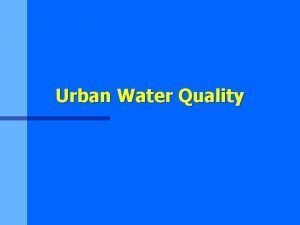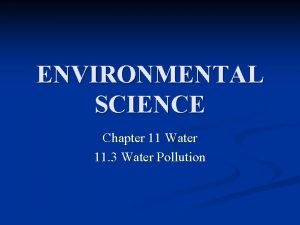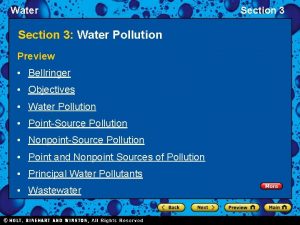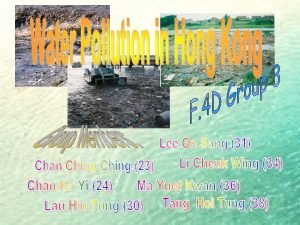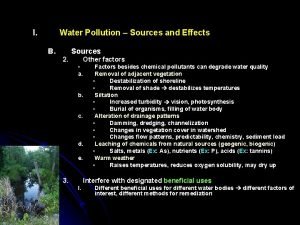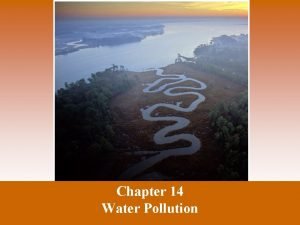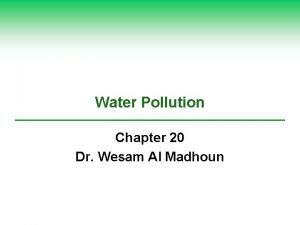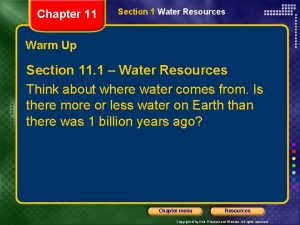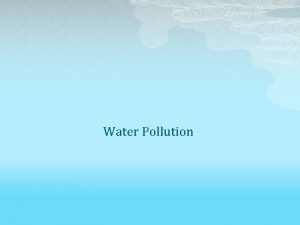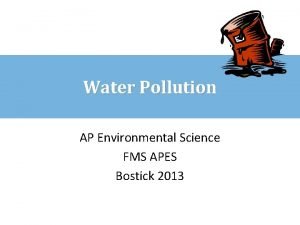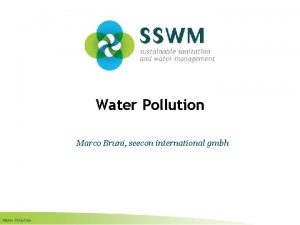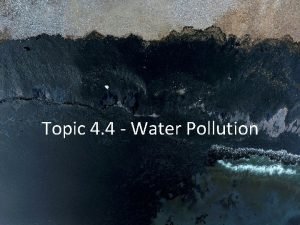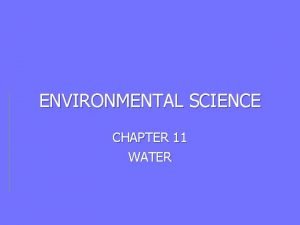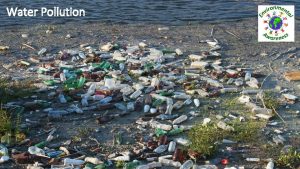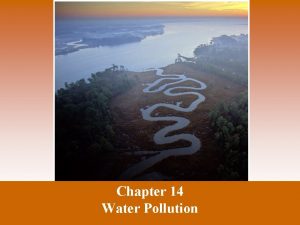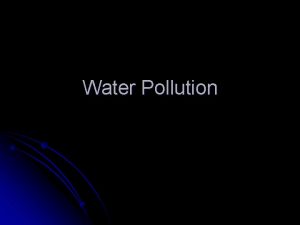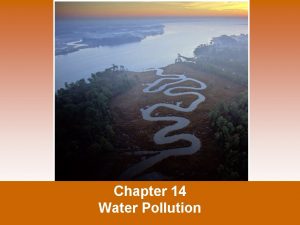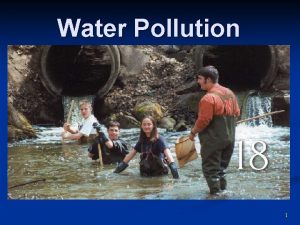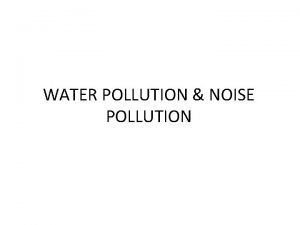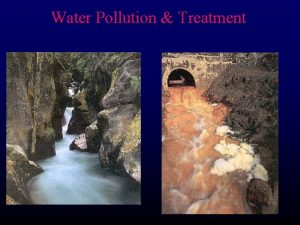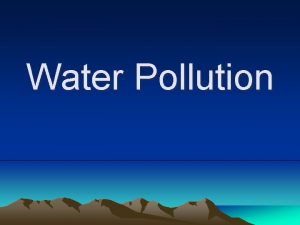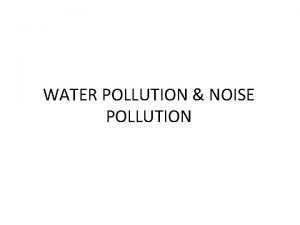Water Pollution Water Pollution n What is water


















- Slides: 18

Water Pollution

Water Pollution n What is water pollution…. n The introduction of harmful substances or products into a body of water

Point and Non-Point n Point Sources: Any single identifiable source of Pollution from which pollutants are discharged, such as a pipe ditch, ship, or factory smokestack (EPA) n Non-Point Sources: Most occur as a result of runoff

Types of Water Pollution Garbage/Human Waste n Agriculture n Industrial Waste n Sediment n Organic Waste n Petroleum waste n

Garbage/Human Waste n n Any trash that is left behind on the beach Sewage n n n Waste that comes from residential or industrial sources A byproduct of sewage waste called sludge It is prohibited in the US but is still released into the ocean by some countries

Agriculture Waste Animal waste can reach the ocean through runoff or seepage through surface soil n Agriculture waste does not get treated n If the area is in a watershed it can flow through rivers and into the ocean n Hog Farm Runoff Manure Runoff

Fertilizers from farms or residential areas can runoff due to rain, irrigation or any other water source n Increased nutrients stimulate algal and other plant growth n Light transmission decreases n Eventual bacterial decay of algae and other plants lowers the dissolved oxygen n

Industrial Waste Primarily enter coastal waters from land based activities n The quantity and characteristics of the waste depend on: n The type of industry n The pre-treatment process while in the plant n Treatment at the wastewater treatment plant n

Industrial Waste n Industrial waste often goes through the same sewer system as domestic and commercial waste, which means there can be high levels of certain heavy metals. Lead n Mercury n Cadmium n Arsenic n

Industrial Waste n Some dump their waste directly into the ocean n n If approved by the Clean Water Act Industrial waste can also become a public health concern if the waste is released into waters that are used for commercial and recreational fishing n Heavy metals can build up in the bodies of seafood (shrimp, oysters, clams, lobsters, fish) which humans could consume

Sediment n When it rains sediments can be washed into bodies of water from Silt & soil n wash off plowed fields n construction and logging sites n urban areas n eroded river banks n

Sediment n Under natural conditions, lakes, rivers, and other water bodies undergo Eutrophication n n Eutrophication : increase in nutrients that cause in increase in algae growth. Decreases the dissolved oxygen levels in the water causing plants and animal populations to decrease. When sediments enter the water… fish respiration becomes impaired n plant productivity is reduced n water depth become reduced n

Organic Pollution n Pollution in the form of organic material n n n Sewage leaves and grass clippings runoff from livestock feedlots and pastures. When natural bacteria and protozoan in the water break down this organic material, they begin to use up the oxygen dissolved in the water. Fish and bottom-dwelling animals cannot survive when levels of dissolved oxygen drop causing large numbers of aquatic organisms to die.

Petroleum Waste Petroleum often pollutes water in the form of oil from oil spills. n The Exxon Valdez and the BP oil spill are examples of this type of water pollution. n A large-scale accident that discharges petroleum is an important cause of pollution along shore lines. n Besides the supertankers, off-shore drilling operations contribute a large share of pollution. n

Petroleum Waste n The graph below shows how many millions of gallons of oil each source puts into the oceans worldwide each year

Oil Spills 5 Largest oil spills Gulf War oil spill Location: Persian Gulf Date: January 23, 1991 volume spilled: 136, 000 - 1, 500, 000 tonnes Barrels: 965, 6000 – 10, 650, 000 Ixtoc oil well Date: June 3, 1979 - March 23, 1980 volume spilled 454, 000 - 480, 000 tonnes Barrels: 3, 223, 400 – 3, 408, 000 Mississippi River Oil Spill Exxon Valdez Atlantic Empress / Aegean Captain Location: Trinidad and Tobago Date: July 19, 1979 Volume spilled: 287, 000 Barrels: 2, 037, 700 Fergana Valley Location: Uzbekistan Date: March 2, 1992 Volume spilled: 285, 000 tonnes Barrels: 2, 023, 500 Nowruz oil field Location: Persian Gulf Date: February 1983 Volume spilled: 260, 000 tonnes Barrels: 1, 846, 000

Top 5: Worst Oil Catastrophes n 10 Largest Oil Spills n

Legislation n Clean Water Act (1972): n n The Act established the basic structure for regulating discharges of pollutants into the waters of the United States. Its principle intent was to ". . . restore and maintain the chemical, physical, and biological integrity of the Nation's waters" To accomplish that objective, the act aimed to attain a level of water quality that "provides for the protection and propagation of fish, shellfish, and wildlife, and provides for recreation in and on the water" by 1983 and to eliminate the discharge of pollutants into navigable waters by 1985.
 Water and water and water water
Water and water and water water Industrial waste causes
Industrial waste causes Questions about water pollution
Questions about water pollution Definition of pollution in simple words
Definition of pollution in simple words Water pollution
Water pollution Water pollution objectives
Water pollution objectives Explain water pollution
Explain water pollution Water pollution in hong kong
Water pollution in hong kong Conclusion of water pollution
Conclusion of water pollution Ddt water pollution
Ddt water pollution Water pollution
Water pollution Solutions to water pollution
Solutions to water pollution Chapter 11 section 3 water pollution answer key
Chapter 11 section 3 water pollution answer key Types of water pollution
Types of water pollution Anaerobic methane digester frq
Anaerobic methane digester frq Ssswm
Ssswm Soil pollution images diagram
Soil pollution images diagram A variety
A variety Water that contains wastes from homes or industry
Water that contains wastes from homes or industry

